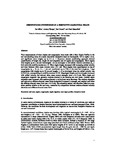Observations of bedforms on a dissipative macrotidal beach
| dc.contributor.author | Miles, Jonathon | |
| dc.contributor.author | Thorpe, A | |
| dc.contributor.author | Russell, Paul | |
| dc.contributor.author | Masselink, Gerd | |
| dc.date.accessioned | 2016-09-09T22:39:26Z | |
| dc.date.available | 2016-09-09T22:39:26Z | |
| dc.date.issued | 2014-01-11 | |
| dc.identifier.issn | 1616-7341 | |
| dc.identifier.issn | 1616-7228 | |
| dc.identifier.uri | http://hdl.handle.net/10026.1/5429 | |
| dc.description | NERC NE/H004262/1 and NE/H02543X/1 DRIBS | |
| dc.description.abstract |
<jats:title>Abstract</jats:title> <jats:p>Field measurements of wave ripples and megaripples were made with a Sand Ripple Profiler in the surf and shoaling zones of a sandy macrotidal dissipative beach at Perranporth, UK in depths 1–6 m and significant wave heights up to 2.2 m. A frequency domain partitioning approach allowed quantification of height (<jats:italic>η</jats:italic>), length (<jats:italic>λ</jats:italic>) and migration rate of ripples and megaripples. Wave ripples with heights up to 2 cm and wavelengths ∼20 cm developed in low orbital velocity conditions (<jats:italic>u</jats:italic> <jats:sub>m</jats:sub> < 0.65 m/s) with mobility number <jats:italic>ψ</jats:italic> < 25. Wave ripple heights decreased with increasing orbital velocity and were flattened when mean currents were >0.1 m/s. Wave ripples were superimposed on top of megaripples (<jats:italic>η</jats:italic> = 10 cm, <jats:italic>λ</jats:italic> = 1 m) and contributed up to 35 % of the total bed roughness. Large megaripples with heights up to 30 cm and lengths 1–1.8 m developed when the orbital velocity was 0.5–0.8 m/s, corresponding to mobility numbers 25–50. Megaripple heights and wavelengths increased with orbital velocity but reduced when mean current strengths were >0.15 m/s. Wave ripple and megaripple migrations were generally onshore directed in the shoaling and surf zones. Onshore ripple migration rates increased with onshore-directed (+ve) incident wave skewness. The onshore migration rate reduced as offshore-directed mean flows (undertow) increased in strength and reached zero when the offshore-directed mean flow was >0.15 m/s. The migration pattern was therefore linked to cross-shore position relative to the surf zone, controlled by competition between onshore-directed velocity skewness and offshore-directed mean flow.</jats:p> | |
| dc.format.extent | 225-239 | |
| dc.language | en | |
| dc.language.iso | en | |
| dc.publisher | Springer Science and Business Media LLC | |
| dc.subject | Surf zone | |
| dc.subject | ripples | |
| dc.subject | megaripples | |
| dc.subject | ripple migration | |
| dc.subject | Sand Ripple Profiler | |
| dc.subject | dissipative beach | |
| dc.title | Observations of bedforms on a dissipative macrotidal beach | |
| dc.type | journal-article | |
| dc.type | Article | |
| plymouth.author-url | http://gateway.webofknowledge.com/gateway/Gateway.cgi?GWVersion=2&SrcApp=PARTNER_APP&SrcAuth=LinksAMR&KeyUT=000331200500004&DestLinkType=FullRecord&DestApp=ALL_WOS&UsrCustomerID=11bb513d99f797142bcfeffcc58ea008 | |
| plymouth.issue | 2 | |
| plymouth.volume | 64 | |
| plymouth.publication-status | Published | |
| plymouth.journal | OCEAN DYNAMICS | |
| dc.identifier.doi | 10.1007/s10236-013-0677-2 | |
| plymouth.organisational-group | /Plymouth | |
| plymouth.organisational-group | /Plymouth/Admin Group - REF | |
| plymouth.organisational-group | /Plymouth/Admin Group - REF/REF Admin Group - FoSE | |
| plymouth.organisational-group | /Plymouth/Faculty of Science and Engineering | |
| plymouth.organisational-group | /Plymouth/Faculty of Science and Engineering/School of Biological and Marine Sciences | |
| plymouth.organisational-group | /Plymouth/Faculty of Science and Engineering/School of Engineering, Computing and Mathematics | |
| plymouth.organisational-group | /Plymouth/REF 2021 Researchers by UoA | |
| plymouth.organisational-group | /Plymouth/REF 2021 Researchers by UoA/UoA07 Earth Systems and Environmental Sciences | |
| plymouth.organisational-group | /Plymouth/REF 2021 Researchers by UoA/UoA12 Engineering | |
| plymouth.organisational-group | /Plymouth/Research Groups | |
| plymouth.organisational-group | /Plymouth/Research Groups/Marine Institute | |
| plymouth.organisational-group | /Plymouth/Users by role | |
| plymouth.organisational-group | /Plymouth/Users by role/Academics | |
| plymouth.organisational-group | /Plymouth/Users by role/Researchers in ResearchFish submission | |
| dcterms.dateAccepted | 2013-12-02 | |
| dc.rights.embargodate | 2015-1-11 | |
| dc.identifier.eissn | 1616-7228 | |
| dc.rights.embargoperiod | Not known | |
| rioxxterms.funder | Natural Environment Research Council | |
| rioxxterms.identifier.project | Dynamics of Rip currents and Implications for Beach Safety (DRIBS) | |
| rioxxterms.versionofrecord | 10.1007/s10236-013-0677-2 | |
| rioxxterms.licenseref.uri | http://www.rioxx.net/licenses/all-rights-reserved | |
| rioxxterms.licenseref.startdate | 2014-01-11 | |
| rioxxterms.type | Journal Article/Review | |
| plymouth.funder | Dynamics of Rip currents and Implications for Beach Safety (DRIBS)::Natural Environment Research Council |


